26th August, 2025
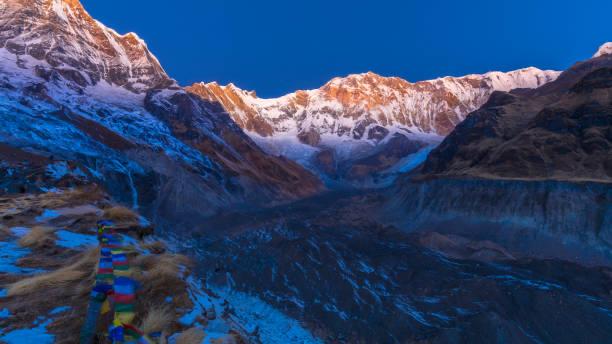
Jul 15, 2024
Best Time for Annapurna Base Camp Trek
- Spring Season (March to June)
- Annapurna Base Camp Trek in Autumn Season (End of September to November)
- Annapurna Base Camp Trek in Winter Season (December to February)
- Annapurna Base Camp Trek in Summer/Monsoon Season (July to Mid-September)
- Is Spring the Best Time for the Annapurna Base Camp Trek?
- Can I Trek to Annapurna Base Camp During the Monsoon?
- What is the Best Season to Trek Annapurna Base Camp?
Embark on your Annapurna Base Camp adventure with our expert guide on the optimal time to trek. The Annapurna Base Camp Trek stands out as one of Nepal’s most captivating trekking destinations, nestled amidst the awe-inspiring Himalayan peaks. This trek offers a unique glimpse into the region’s stunning natural beauty.
The diverse Annapurna terrain presents a mesmerizing array of landscapes, from verdant forests to dramatic mountain vistas. The trek is renowned for its unparalleled Himalayan scenery, with the majestic Annapurna range providing a breathtaking backdrop at every turn.
In addition to its natural splendor, the Annapurna region is rich in flora and fauna, enhancing the journey with vibrant rhododendron blooms, intriguing wildlife, and the melodic sounds of diverse bird species.
Weather conditions play a crucial role in planning your trek to Annapurna Base Camp. The region's mountainous climate can be unpredictable, with rapidly changing weather patterns. Choosing the right season is essential for a safe and memorable trekking experience.
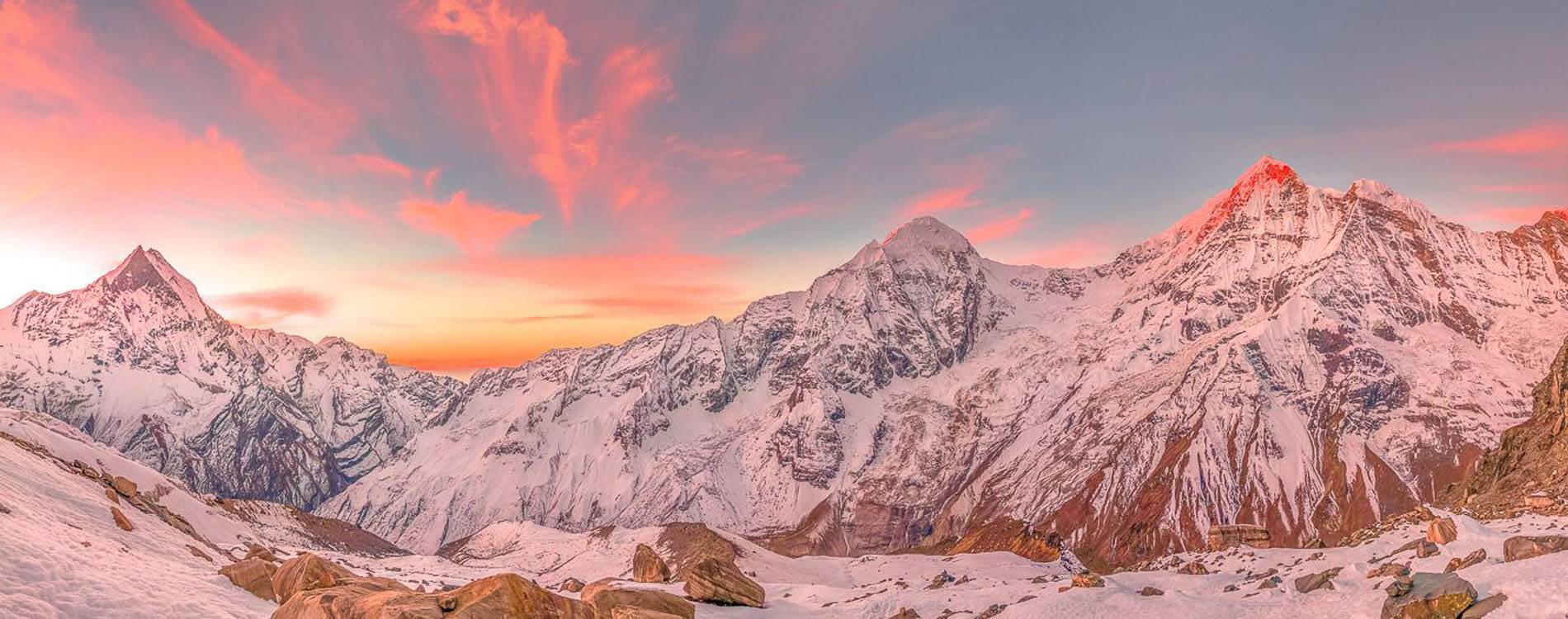
7 DAYS ANNAPURNA BASE CAMP TREK
Short on time – big on beauty!The 7 days Annapurna Base Camp Trek takes you to all the major attractions – but in less time than other treks to the Annapurna region. Take in the spectacular soaring sn...
This guide will delve into the various seasons and their distinct characteristics, helping you select the best time for your trek. Whether you’re drawn to the colorful rhododendron blooms of spring, the clear skies of autumn, the winter challenge, or the lush greenery of the monsoon, each season offers unique benefits and challenges.
Join us as we explore the best times to undertake the Annapurna Base Camp Trek and find the ideal season to suit your trekking preferences.
Spring Season (March to June)
Embarking on the Annapurna Base Camp Trek during the spring months of March through June offers a truly exceptional experience in the heart of the Nepalese Himalayas.
Spring is widely regarded as one of the best times to undertake the Annapurna Base Camp Trek, and it's easy to see why. During this season, the weather in the Annapurna region is remarkably pleasant. Days are pleasantly warm, providing trekkers with the chance to explore the stunning landscapes without the discomfort of harsh cold.

15 DAYS ANNAPURNA CIRCUIT TREK
A WILD ADVENTURE AMONG SOARING PEAKS - THE DEEPEST VALLEY ON EARTH & EXPOSURE TO UNIQUE CULTURES.THIS TREK HAS IT ALL!The 15 Days Annapurna Circuit Trek is time well spent and will leave you with...
That said, be prepared for cooler temperatures at night, which can plummet to as low as -8 degrees Celsius.
Spring also brings a captivating transformation to the landscape. The lush green forests come alive, and the trail becomes a vibrant display of rhododendron and magnolia blossoms. This explosion of color creates a breathtaking visual spectacle.
However, the popularity of the spring season means the trails can be quite busy. It’s a good idea to plan your trek well in advance and secure your accommodations early to ensure a smooth and enjoyable journey.
As spring unfolds from March to June, the Annapurna Base Camp Trek becomes an ideal adventure in the Nepalese Himalayas. The melting snow and milder, more predictable weather offer the perfect conditions for trekking, free from the concerns of unexpected snowfall or severe cold snaps.
During this season, temperatures are generally moderate during the day, although it’s wise to pack layers to stay warm on chilly nights and to protect yourself from the sun during daylight hours.
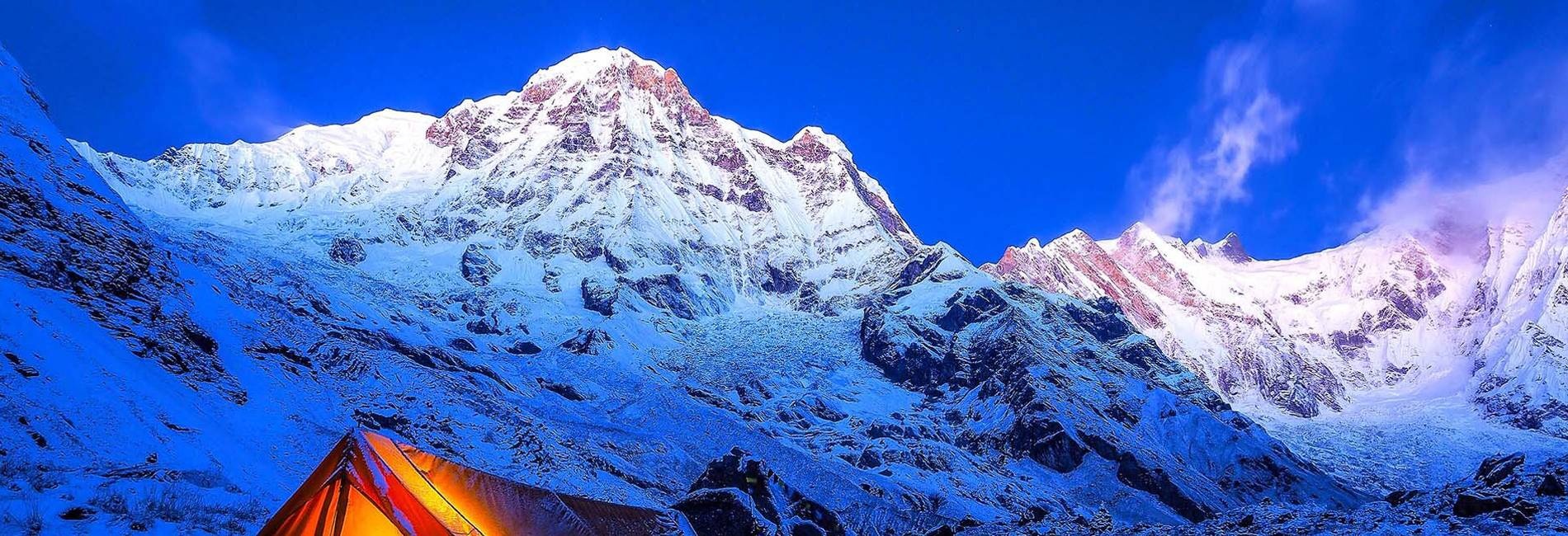
ANNAPURNA BASE CAMP TREK 8 DAYS
The 8 days Annapurna Base Camp Trek is the most popular and amazing trek in the Annapurna region which offers combines remarkable Himalaya vistas, traditional Gurung and Magar village life, and dense...
One of the most enchanting aspects of trekking in spring is witnessing the breathtaking sunrise views from Annapurna Base Camp. As the first light touches the snow-capped peaks, the entire landscape is bathed in a warm, golden glow—an awe-inspiring sight that leaves a lasting impression.
Additionally, the spring season enhances the sensory experience of the trek. You’ll be serenaded by the melodic chirps of a variety of birds and see thousands of butterflies fluttering along the path, adding a vibrant touch to the journey.
The weather during this time is pleasantly stable, with temperatures neither too hot nor too cold and minimal precipitation. The dry conditions make the trails less slippery, contributing to a safer and more enjoyable trekking experience.
Overall, trekking to Annapurna Base Camp in spring offers an unforgettable adventure, showcasing nature’s beauty in full splendor and allowing you to experience the Himalayas at their most magnificent.
Annapurna Base Camp Trek in Autumn Season (End of September to November)
Trekking to Annapurna Base Camp during the autumn months, from late September through November, is often considered the best time to undertake this iconic adventure. This period, marking the pre-winter phase in Nepal, offers some of the most favorable trekking conditions of the year.
Autumn is celebrated for its moderate temperatures and ideal climate. With pleasantly warm days and crisp, cool mornings and evenings, the weather provides a comfortable setting for trekking. The clear and precise weather typical of autumn is particularly appealing, thanks to the cleansing effects of the preceding monsoon rains. This results in exceptional visibility, allowing trekkers to fully enjoy the breathtaking panoramas of the Annapurna range.
The average daytime temperatures in autumn range from a comfortable 12 to 20 degrees Celsius, making it an ideal time for trekking without the extremes of intense heat or cold. However, be prepared for colder nights, with temperatures potentially dropping to around -3 to -4 degrees Celsius.
One of the unique highlights of trekking in autumn is the sensory experience of the blooming flowers along the trail. The fragrance of these blossoms adds a delightful dimension to your journey.

ANNAPURNA BASE CAMP TREK
The Annapurna Base Camp (ABC) Trek via Ghorepani Poon Hill Trek offers a truly unforgettable Himalayan adventure, combining stunning panoramic views with the rich cultural tapestry of the region. This...
Autumn is also the harvest season in Nepal. As you trek through terraced fields and rural landscapes, you’ll witness the local agricultural practices and gain insight into the rural life of Nepalese communities. This is an excellent opportunity to observe and appreciate the traditional farming methods and the vibrant rural culture.
While the trails can be crowded during this season, with many trekkers sharing the path and staying in tea houses, it also offers a chance to meet fellow adventurers from around the world. The busy teahouses become lively social hubs, fostering a sense of camaraderie and shared adventure among trekkers.
Additionally, autumn coincides with Nepal’s major festivals, Dashain and Tihar. These cultural celebrations provide trekkers with a unique opportunity to engage with local traditions, participate in festive activities, and gain a deeper appreciation of Nepalese culture.
In summary, trekking to Annapurna Base Camp in autumn combines perfect weather conditions, stunning scenery, and a vibrant cultural atmosphere. The clear skies, comfortable temperatures, and the lively trail interactions create an unforgettable trekking experience. Autumn is undoubtedly the ideal season to explore the Annapurna Base Camp and immerse yourself in the beauty and culture of Nepal.
Annapurna Base Camp Trek in Winter Season (December to February)
Embarking on the Annapurna Base Camp Trek during the winter months of December, January, and February is the most adventurous and demanding choice for trekkers seeking an extreme challenge. The winter season transforms the trek into a rigorous expedition, marked by severe weather conditions and a dramatically snow-covered landscape.
Winter brings a sense of solitude to the Annapurna region, with a significant reduction in the number of trekkers. This quiet, snow-clad environment offers a stark and serene beauty, providing a unique experience amidst the rugged grandeur of the Himalayas.
Temperatures during winter are harsh, with daytime highs ranging from 0 to 5 degrees Celsius and nighttime lows dropping to a frigid -10 to -15 degrees Celsius. These extreme cold conditions present significant challenges, making staying warm essential. Heavy snowfall blankets the trails, increasing the risk of avalanches and making travel more treacherous.
Given these conditions, winter trekking is not recommended for novice or inexperienced hikers. The harsh environment demands robust preparation and experience. Trekkers must be equipped with heavy-duty clothing, including insulated woolen coats, to fend off the biting cold. The risk of avalanches and obstructed trails due to snowfall makes navigating the path difficult and potentially hazardous.
Despite these challenges, the winter season offers a rare and enchanting beauty. The Annapurna landscape becomes a pristine wonderland, with majestic glaciers and snow-covered peaks. Encountering wildlife and flora adapted to the cold adds to the unique allure of this time of year.
Staying hydrated is crucial in the cold, as dehydration can occur more easily. Additionally, the risk of slipping on icy trails requires extra caution to avoid serious injuries.
In conclusion, trekking to Annapurna Base Camp during the winter season is an extraordinary endeavor, suited only for seasoned trekkers prepared for the extreme conditions and inherent risks. While the winter landscape is breathtakingly beautiful, ensuring safety and being fully aware of the potential hazards are paramount.
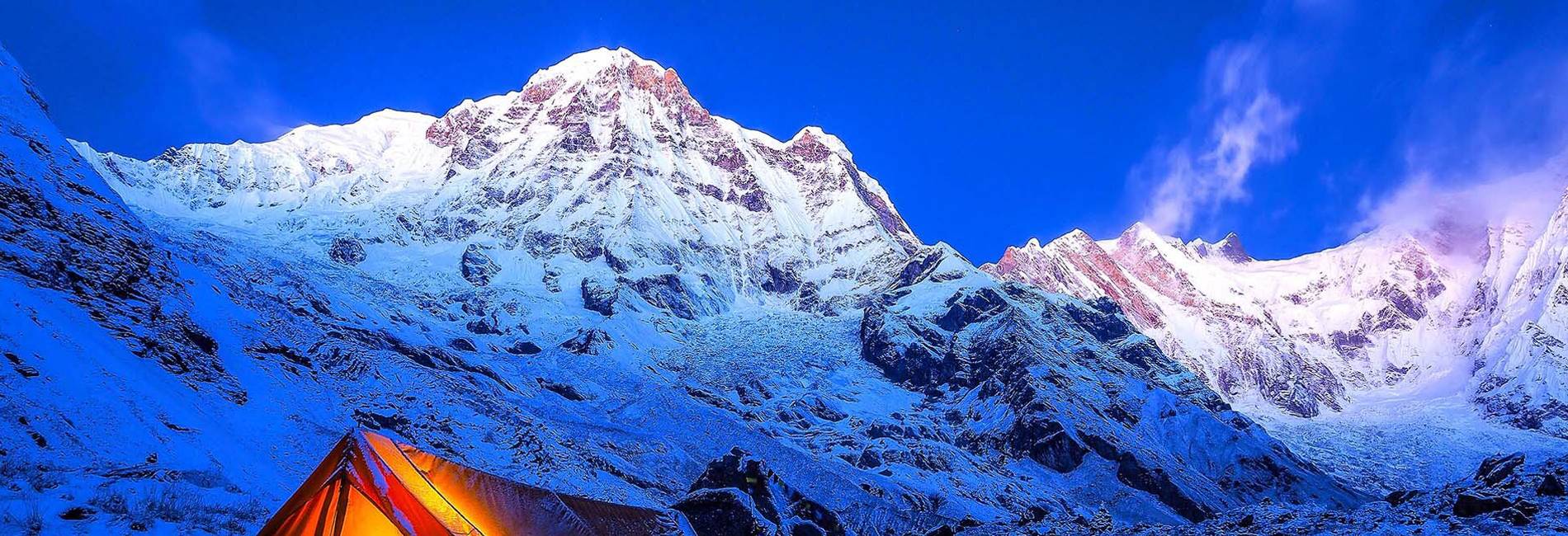
13 DAYS ANNAPURNA BASE CAMP TREK
Discover why “The Annapurna Base Camp (ABC) trek is world-famous. Here is a sample of soaring snow-capped peaks you will see along the trail: Mt. Dhaulagiri (8167m), Mt. Annapurna I (8091m) Mt. M...
Annapurna Base Camp Trek in Summer/Monsoon Season (July to Mid-September)
Trekking to Annapurna Base Camp during the summer and monsoon season, from July through mid-September, offers a unique adventure in Nepal marked by significant weather changes. This period, characterized by the monsoon rains and summer temperatures, presents both distinctive challenges and rewards.
During the monsoon season, temperatures in the Annapurna Region generally range from 20 to 25 degrees Celsius during the day, creating a pleasantly warm trekking environment. However, nights can be quite chilly, with temperatures dropping to around -1 to -2 degrees Celsius, so it’s important to be prepared for colder conditions.
The monsoon season brings its own set of challenges. The humid and wet conditions are ideal for leeches, which can be a nuisance on the trails. To mitigate this, trekkers should wear full-length clothing and high-quality anti-leech gear, and pack waterproof clothing, including rain jackets and pants. Sturdy, anti-slip boots are also essential for handling the slippery, rain-soaked paths. A wide-brimmed hat can help protect against both sun and rain, ensuring comfort throughout the trek.
Additionally, the heavy rains can lead to landslides on some parts of the trekking routes, requiring flexibility and adaptability from trekkers. It's important to stay informed about trail conditions and be prepared for possible disruptions.
One of the highlights of trekking during the monsoon season is the stunning post-rain vistas. When the rain subsides, the clear skies reveal breathtaking views of the Annapurna range. The lush greenery, enhanced by raindrops, adds a vibrant charm to the landscape, making the experience visually captivating.
The monsoon season is also a quieter time on the trails, with fewer trekkers around. This off-season period offers a sense of tranquility and solitude that can be highly rewarding for those who seek a more peaceful trekking experience.
However, travelers should be aware of potential flight delays and cancellations due to the monsoon weather. Heavy rains and low visibility can impact domestic flights to and from the trekking regions, so it’s wise to allow extra time in your travel plans to accommodate possible delays.
In conclusion, trekking to Annapurna Base Camp during the summer and monsoon season provides a distinct perspective on this beautiful region. While the season presents challenges such as leeches, landslides, and weather-related disruptions, it also offers the chance to experience the Himalayas in a unique and pristine setting. With careful preparation and flexibility, trekkers can enjoy a rewarding and memorable adventure.
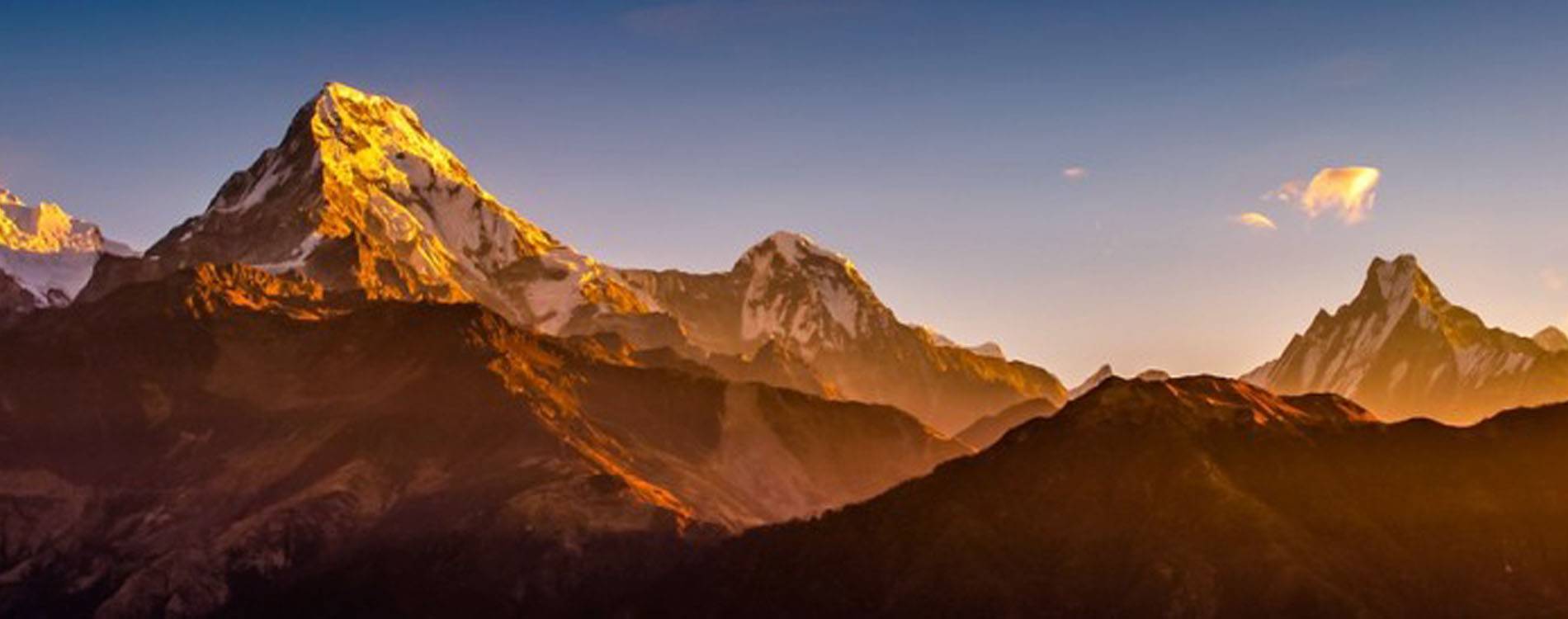
12 DAYS ANNAPURNA BASE CAMP TREK
DOUBLE THE ADVENTURE IN JUST 12 DAYS! The 12 Day Annapurna Base Camp Trek combines two well-known and popular treks into one - the Ghorepani Poon Hill Trek and the Annapurna Base Camp Trek (ABC)....
Is Spring the Best Time for the Annapurna Base Camp Trek?
Yes, Spring is considered one of the best times for the Annapurna Base Camp (ABC) trek. During this season, which spans from March to June, the weather is generally favorable. You can expect warm days, clear skies, and temperatures that are neither too hot nor too cold, providing a comfortable environment for hiking. The dry conditions during Spring ensure that the trails are not slippery, which enhances the overall trekking experience.
Can I Trek to Annapurna Base Camp During the Monsoon?
Yes, trekking to Annapurna Base Camp during the monsoon season (July through mid-September) is possible, but it presents a unique set of challenges. Monsoon trekking offers fewer crowds, which can be a plus, but you should be prepared for potential landslides, humid and wet conditions, and flight delays due to heavy rain and low visibility. Adequate planning, appropriate gear, and caution are essential if you choose to trek during this period.
What is the Best Season to Trek Annapurna Base Camp?
The optimal seasons for trekking to Annapurna Base Camp are Spring (March to June) and Autumn (end of September to November).
- Spring: You can enjoy clear skies, moderate temperatures, and vibrant rhododendron blooms. The weather is generally stable, making it a popular time for trekkers.
- Autumn: The weather remains stable with clear views and pleasant temperatures. This season offers some of the finest trekking conditions with spectacular vistas of the Annapurna range.
Ultimately, the best time for your Annapurna Base Camp trek depends on your personal preferences, trekking experience, and your readiness to embrace the characteristics of each season.
Regardless of when you decide to go, thorough planning, proper preparation, and an appreciation for the region’s stunning beauty and culture will ensure a memorable and rewarding adventure.
For further assistance with your trip booking, please contact Sherpa Expedition and Trekking at WhatsApp +9779866007038 or email info@sherpaexpeditiontrekking.com .
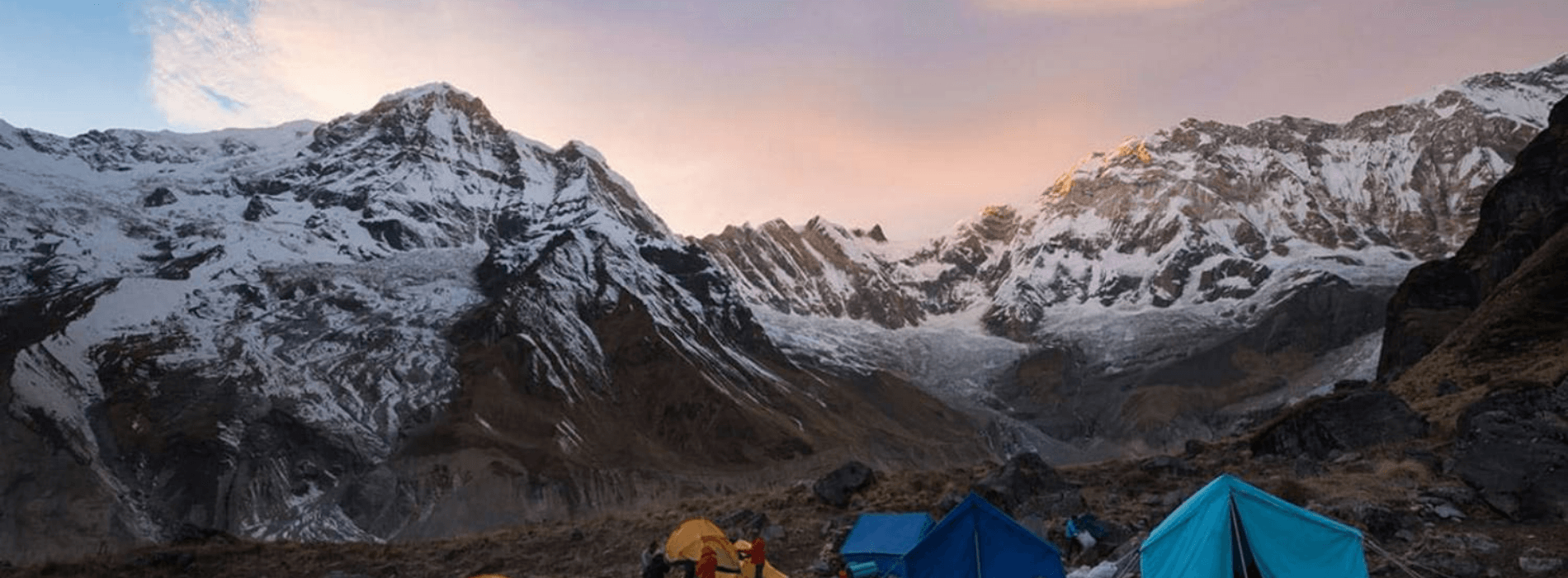
ANNAPURNA BASE CAMP TREK 6 DAYS
The 6 days Annapurna Base Camp Trek is an ideal adventure for those people who have a tight schedule but still want to experience the amazing landscape and the fascinating lifestyles of the Gurung cul...
Any Questions? Let Us Know.
Recent Posts
17th June, 2025


















